![]()
![]()
![]()
Use LEFT and RIGHT arrow keys to navigate between flashcards;
Use UP and DOWN arrow keys to flip the card;
H to show hint;
A reads text to speech;
19 Cards in this Set
- Front
- Back
|
What is a mutation? |
a heritable change in the genetic material. a mutation is a change in thesequence of DNA of an organism or cell, because DNA is the genetic material, and it is DNA that is passedfrom generation to generation. Changes can be very small (e.g. altering a single base pair) or very large,sometimes involving entire chromosomes and hundreds of genes. A change in the DNA sequence of anysingle gene can result in a different gene product (i.e. protein) than the normal, wild-type gene, dependingon the type of change. In terms of the Central Dogma, a change in the DNA will be copied into RNA, whichwill be translated into protein. |
|
|
True or False? The machinery of transcription and translation knows if a gene iswild-type or not |
False-- it does not know |
|
|
What is the difference between mutations in single cell organisms and multicellular organisms? |
Mutations in single-celled organisms (e.g.bacteria, yeast) will be passed to the nextgeneration automatically. In multicellular orgs, mutationswill be passed on to the next generation only ifthose mutations are present in the germline(the cells that will undergo meiosis and form thegametes). Mutations that occur in somatic cellswill not get passed on, |
|
|
Can mutations in somatic cells be passed on? Are they harmful? |
They will NOT be passed on, but they can affect the organism itself. One example of a consequence of somatic mutation is (possibly) the generation of cancer |
|
|
Types of mutations |
1.Changes in the chromosome number, or aneuploidies, result from a failure ofsegregation (called a non-disjunction) - Ex: Down syndrome. |
|
|
what are point mutations? |
small changes that affect a single gene. |
|
|
Causes of Mutations |
1.replication errors. During DNA replication,a wrong base can sometimes be inserted by the DNA polymerase. |
|
|
How can the causes of mutations be corrected/handled? |
1. Replication errors- there are mechanisms that can detect and correct thesemismatches (3'-5' exonuclease (proofreading), excision repair), a small proportionof these can stay in the DNA. After another round of replication, amutation can become permanent. |
|
|
What is a silent mutation? |
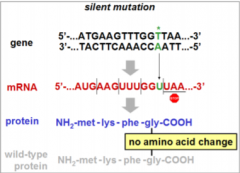
Consider a base substitution in which the CGbase pair in wild-type has been replaced with aTA base pair.If we look at the resulting polypeptide sequence,no change results in the amino acid sequence.Therefore, this mutation will have no effect onthe protein |
|
|
What is a missense mutation |
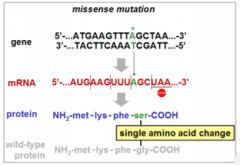
In this base substitution, a GC base pair in wildtypehas been replaced with an AT base pair. Thishas changed the amino acid that will occur in thefourth position – i.e., an amino acid substitution.Depending on where in a polypeptide an aminoacid substitution is, and on what kind ofsubstitution, this can have very little effect orcould completely change the function of theprotein. We will be looking at examples later. |
|
|
What is a nonsense mutation? |
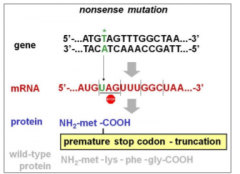
Here a base substitution has changed a codon for anamino acid into a stop codon (a nonsense codon).Because this signals the end of translation of anmRNA, the remainder of the polypeptide will not bemade, even though the sequence downstream ofthe nonsense mutation is the same as in wild-type.Nonsense mutations, especially those that occurearly in a coding region, can completely destroy thefunction of a gene |
|
|
What is a frame shift mutation? |
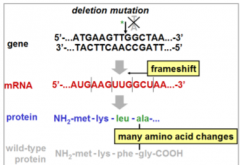
Here, a deletion of a single base pair has resulted in acoding region that has undergone a frameshiftdownstream of the missing base. Thus, although onlyone base is missing, the remainder of the codingregion will be read incorrectly – out of frame.Insertion mutations have a similar frame-shift effectas deletion mutations. Note that insertions ordeletions of a multiple of 3 base pairs will allow therest of the protein to be made normally |
|
|
What is hemglobin? What is it composed of? |
Hemoglobin is an oxygen-carrying molecule that is essential forour survival. The protein consists of four subunits: Two alpha (α)and two beta (β). Each subunit carries a heme group, containingiron (Fe), which carries oxygen. |
|
|
How does sickle cell disease occur? |
a single base pair change,from an AT base pair in the wild-typegene to a TA base pair in the HbS allele. This results in a substitution of aglutamic acid with a valine as comparedwith the wild-type Hb β protein.The glu -> val change is a profound one: Glutamic acidhas a polar, acidic charged side chain, while valine has anonpolar side chain. While the wild-type and HbS formsof hemoglobin still function as oxygen carriers, at lowoxygen concentrations, the HbS form is able to formlong 'fibers' that cause the cells to have a sickledappearance. |
|
|
What do homzygotes for the HbS allele show |
physical abnormalities, including anemia and failure ofvarious organs including the kidney and heart. |
|
|
What do heterozygotes for the HbS allele show? |
one copy of the wild-type alleleand one copy of the HbS allele are not completely normal but have a mild phenotype that shows at verylow oxygen tensions (e.g. at high altitudes). Hence, the HbS and wild-type alleles are actually ‘co-dominant’,meaning that both contribute to the phenotype in a heterozygote |
|
|
Do we expect sickle cell to persist in the human population? Why does it persist in Africa? |
No, it is directly related with Plasmodium fulciparum, the agent that causes malaria. The sickle cell allele, in a heterozygous individual, appears to provide a resistance tomalaria infection because the parasite cannot replicate in the blood of sickle cell traitcarriers. This interplay of genetics with environment explains why the HbS allele continues to be passedfrom generation to generation |
|
|
What is malaria and how does it work? |
Malaria results from infection of humans withPlasmodium, which is introduced into the bloodstreamby the bite of a mosquito. In a human, the parasites willend up in the liver, where they enter the bloodstream,consume hemoglobin, replicate and produce moreparasite. |
|
|
How does the HbS allele play out in SS, Ss and ss individuals and their interaction with Malaria, and sickle cell disease? |
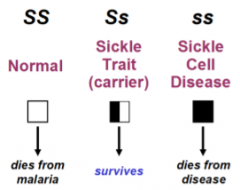
|

